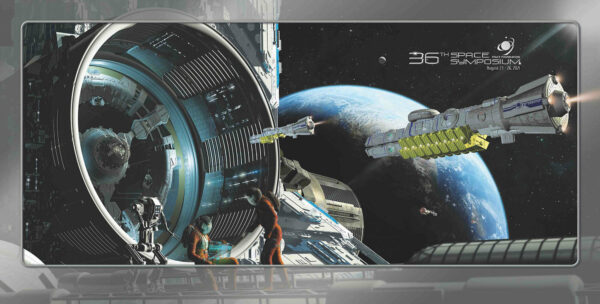
This week leaders from the Laboratory for Atmospheric and Space Physics (LASP) and other University of Colorado (CU) affiliates participated in the 36th Space Symposium. This international meeting, held each year in Colorado Springs, Colo., brings together thousands of participants from the civil, commercial, and national security sectors of space to discuss space-related issues, policies, and future directions. The University of Colorado is currently the #1 public university recipient of NASA research awards.
LASP and CU aerospace representatives hosted an exhibit booth to highlight the University’s extensive space science research and development experience. CU leaders and students from LASP, the Ann and H.J. Smead Department of Aerospace Engineering Sciences and the CU Colorado Springs College of Engineering and Applied Science, as well as the Director of CU Boulder AeroSpace Ventures, were in attendance.
Among university research institutions, LASP is unusual in that it engages in the full cycle of space exploration, from conception to instrument and satellite design, mission operations, and, ultimately, scientific discovery. The Lab has also played a leading role in developing smallsat technologies and utilizing them to address key scientific questions. LASP, which began a decade before NASA was founded, is the only research institute in the world to have sent instruments to all eight planets—and to Pluto.
“Attending the Space Symposium is a wonderful opportunity to inform key players from every area of the space industry about LASP’s many areas of expertise and excellent track record of developing new technologies,” says Thomas Sparn, the director of engineering at LASP. “This is our 18th time attending, and each year the event has grown to include more domestic and international participants. Because of the global pandemic, this year’s event was somewhat smaller than in years past, but we still hosted more than 4,000 visits at our booth.”
The Space Symposium brings together attendees representing every aspect of the space enterprise. These include research and development facilities, educational institutions, space agencies, commercial businesses, federal and state government agencies, and private firms from around the world.
“Engaging with such a broad cross section of the aerospace community at the Space Symposium is invaluable,” says Carl Gelderloos, the technology and new business lead at LASP. “This year offered many opportunities to initiate discussions on the next round of innovative collaborations.”
LASP’s involvement in implementing a wide variety of missions across all sectors of this enterprise, including government, commercial, and international, provides an excellent platform for Space Symposium outreach. The instruments currently and slated to fly on the International Space Station (TSIS-1 and CLARREO Pathfinder), four instruments (EXIS) delivered to the GOES-R+ platforms, eight active NASA, NSF, and international cubesat programs, a key instrument (SUDA) being readied for NASA’s flagship Europa Clipper mission, and a partnership with the United Arab Emirates implementing the Emirates Mars Mission are tangible examples of the Lab’s diversity in innovation and scientific discovery.
“This coordinated presence at the Space Symposium is a great example of how leaders and units from across the university system can collaborate to highlight CU’s extensive aerospace expertise and the many resources our campuses have to offer,” says Chris Muldrow, the Smead Program Director in the Ann and H.J. Smead Department of Aerospace Engineering Sciences. “We are a world leader in aerospace and related fields, and Space Symposium offers an opportunity to engage our partner communicates for research, workforce development, and related programs. Our impact is multiplied when we bring the best of CU aerospace to the space ecosystem.”



